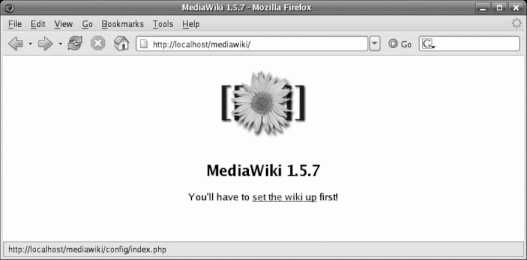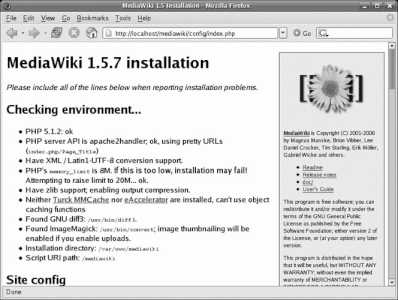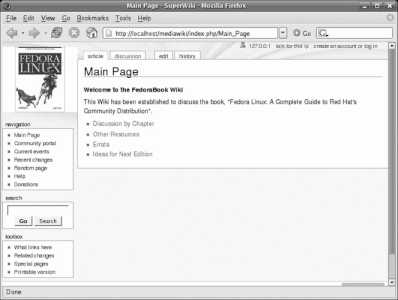7.10.1. How Do I Do That?
MediaWiki requires a MySQL server. yum won't automatically install a MySQL server when you install MediaWiki because MySQL isn't truly a dependency: the database server doesn't have to be on the same computerbut for a small installation, that makes the most sense.
To configure MediaWiki, start your web server (if it's not already running) and then, using a browser on the same computer as the MediaWiki software, go to http://localhost/mediawiki/ . You will see an introduction page like that in Figure 7-27 , informing you that the software must be configured before use.
Figure 7-27. MediaWiki before initial configuration

To configure the software, click on the link provided. The page shown in Figure 7-28 will appear.
Figure 7-28. MediaWiki configuration page

This page presents the results of some initial configuration tests, followed by a form that you must fill in with configuration information. The fields on this form are:
Site name
Input an opaque string (no spaces and no punctuation marks) of letters and numbers for the name of your Wiki.
Contact email
Enter an email address that can be used to contact the Wiki administrator. It is probably best to use an email alias here.
Language
The language for the Wiki prompts and messages (the content can be in any language, regardless of the value you choose here).
Copyright/license metadata
The license that will be used to tag the Wiki contents. You can choose not to tag your pages with license information, or you can use one of two types of open content licenses: GNU Free Documentation License (GNU FDL) or a Creative Commons license. If you are not sure what to use, select "no license metadata ."
Sysop account name and password
Enter the username of the system operator ( sysop ) or Wiki administrator. This user does not have to have a Fedora login account. The password must be entered twice to verify that it is typed correctly.
Shared memory
Use a memory cache system for performance acceleration. This is not necessary for small installations.
E-mail (general)
Enable all email operations. In almost all cases, this should be left on.
User-to-user e-mail
Enable users to send mail to each other; whether this makes sense depends on the intended use of your Wiki.
E-mail notification
Select the events that trigger an automatic notification email. Use the middle setting for most small-to-medium Wikis.
E-mail address authentication
If enabled, this feature sends a token to the email address of newly registered users to verify that the email address is valid. This presents a minor inconvenience to your users, but prevents email from being sent to invalid addresses and, more importantly, prevents a user from entering someone else's email address.
MySQL server
Leave this set to localhost if the MySQL server is on the same computer as the MediaWiki software.
Database name, DB username, and DB password
The name of the MySQL database, and the username and password for the MySQL access account, respectively. Leave the default values for the Database name and the DB username, and make up a new password (twice) for the DB password.
Database table prefix
If you are running more than one instance of MediaWiki, set this to a unique value for each instance. Otherwise, leave this field blank.
Database charset
Leave this value set to "Backwards-compatible UTF-8."
Super user and Password
The MySQL database and access account for the Wiki can be created by hand, or you can enter the user ID and MySQL password for the database administrator here, and MediaWiki will create the database and access account automatically.
This is the MySQL administrator account (root) and the MySQL password for that account; do not enter the Fedora root password!
Once you have entered this information, click the Install button at the bottom of the page. You will see a confirmation page.
At this point, copy the configuration file from the config directory to the main mediawiki directory:
# cp -v /var/www/mediawiki/config/LocalSettings.php /var/www/mediawiki
\Q/var/www/mediawiki/config/LocalSettings.php' -> \Q/var/www/mediawiki/LocalSettings.php'
You can now click the link at the bottom of the confirmation page or go to http://
The only other customization that is necessary is to install a new logo image. The image should be 155 pixels wide and 135 pixels tall and in .gif , .png , or .jpg format. Edit /var/www/mediawiki/LocalSettings.php and find the line that reads:
$wgLogo = "$wgStylePath/common/images/wiki.png";
Change the path on the righthand side of the equal sign to the path of your image location, relative to the Apache Document Root. For example, if your image is in /var/www/mediawiki/images/draft-cover.png , edit this line to read:
$wgLogo = " /mediawiki/images/draft-cover.png ";
You can then edit the front page of your Wiki by clicking on the "edit" link at the top of the page; changes are made using the same Wikitext format used on Wikipedia. Figure 7-29 shows a fully configured MediaWiki installation.
Figure 7-29. Configured MediaWiki front page

